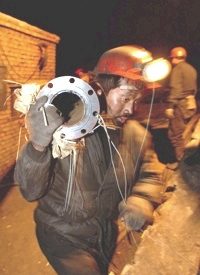
China is the largest producer of rare earth elements, or “rare earths, “which are important for many sophisticated technology applications. In fact, it has been estimated that China has 97 percent of the current production of these elements. The Chinese government has restricted exports of these rare earths and at least part of the reason appears to be to push up the price of the rare earths on the international market, and closely related to that was the goal of giving Chinese manufacturers a competitive advantage in international markets by giving these operations lower production costs of the rare earths that they use.
Recently the Chinese government ordered that the largest Chinese producer of rare earths suspend output for a month and that only 11 Chinese companies be licensed to sell abroad, down from 26 companies in the first half of the year. The Commerce Ministry said that rare earth exports for the first 11 months of 2011 totaled 14,750 tons, which is only half the annual quota. The drop in prices for Chinese rare earths since August of this year has, in some cases, been dramatic: neodymium has gotten 45 percent cheaper, terbium oxide has dropped 31 percent in price, and lanthanum oxide has fallen 31 percent.
Those 17 rare earth elements, which include long and unfamiliar names such as dysprosium and lanthanum, are not truly rare. In fact, cerium is the 25th most common element in the crust of our planet (making it, roughly, as common as copper). The effort to extract these rare earths, however, is very labor intensive, which is why Brazil and India were long among the greatest producers of these elements in global commerce 50 years ago. The rare earths do not commonly appear in concentrated forms, like iron or gold. China does have a disproportionately large amount of the known rare earths deposits on the planet, an estimated 30 percent, compared to its landmass, which is about 6.5 percent of the planet’s total, but that is far from a monopoly and is, at best, a slight competitive advantage.
The United States, Canada, and Australia, which also are geographically large countries (like China, India, and Brazil), stopped manufacturing rare earths about 30 years ago because it was unprofitable. The rising cost, driven up by the Chinese government’s exercise of quotas and licenses, is already pushing traditional producers of rare earths, now including Russia and Malaya, to begin new production operations that ought to begin to affect global supply in 2015.
Today, what has troubled manufacturers outside of China is that an actual interruption of supply would bring some sorts of production lines to a half, at least until other production could be found. The risk for China, of course, is that if the Chinese supply of rare earths is perceived as being unreliable, then several different situations would arise.
First, the production operations in other nations would find the market much more attractive because the certainty of supply, as much as the cost, is critically important to high technology companies. Second, salvaging and reusing rare earths would become more economically feasible. Third, stockpiling of supplies, when access to rare earths was again obtained by producers, would be calibrated to enable production to continue after interruptions. Fourth, manufacturers would find alternatives to rare earths and products would more rapidly evolve into new incarnations which did not require rare earths.
The consequence of that would mean that current Chinese rare earth production and the industrial infrastructure would suddenly lose a great deal of its value. The laws of supply and demand, the natural changes in free markets, operate even when governments try to create monopolies or cartels. During the American Civil War, the need for “King Cotton” was assumed to be an ace of trumps. The great productivity of the Cotton Belt in the South was real, but India and Egypt and other countries proved also able to grow the cotton needed for the mills of Lancaster.
Natural rubber was once so valuable that a magnificent opera house was built in Manaus, Brazil’s rubber capital, deep up the Amazon. Brazilian gunboats patrolled the Amazon to prevent anyone from smuggling rubber plants or seeds out of the country, which would have threatened Brazil’s monopoly. We still need materials with the elasticity of rubber, but Malaya produces much of that rubber now and a whole range of artificial materials made largely out of petrochemicals, has to a great extent replaced rubber in manufactured consumer goods.
Those nations that imagined that they could create an effective cartel in oil ran into a variety of problems: When OPEC nations such as Iran and Iraq were engaged in bloody wars, it was hard to maintain organizational cohesion; as the price of oil rose, fuel-saving in automobiles became popular; and, of course, because the value of oil suddenly increased for everyone on Earth, fields in America that were once not worth exploring suddenly became a good risk and other fields in which it has been uneconomical to produce proven supplies suddenly became profitable. This lesson in the history of economies and markets, which has been learned and re-learned throughout human history, is about to be learned again.
Photo: A rescuer carries a drainpipe into a mine in China’s Shanxi province in 2006: AP Images



